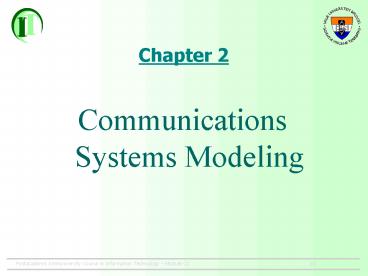Communications Systems Modeling - PowerPoint PPT Presentation
1 / 28
Title:
Communications Systems Modeling
Description:
... Interuniversity Course in Information Technology Module C1 p1. Chapter ... using a level n protocol. Physical ... communications services. Internet ... – PowerPoint PPT presentation
Number of Views:66
Avg rating:3.0/5.0
Title: Communications Systems Modeling
1
Chapter 2
- Communications Systems Modeling
2
Contents
- Introduction
- Example a diplomatic negotiation
- Principles of a layered model
- Connection oriented and connectionless
communications - Communication networks according to a layered
model
3
Contents
- Introduction
- Example a diplomatic negotiation
- Principles of a layered model
- Connection oriented and connectionless
communications - Communication networks according to a layered
model
4
Layered Network Models
- The problem
- Complexity of networked systems
- The solution
- Decomposition into independent subsystems
- Layered network model
- Introduced by IBM (SNA, 1971)
- Standardized by ITU (X200) and ISO (7498)
- Method universally adopted
- Standards not really obeyed in practice
5
Contents
- Introduction
- Example a diplomatic negotiation
- Principles of a layered model
- Connection oriented and connectionless
communications - Communication networks according to a layered
model
6
A diplomatic negotiation
Political arguments
Service Access Points
Translation Cryptography Transmission
7
A diplomatic negotiation
Political arguments
Service Access Points
Single language messages
Cryptography Transmission
8
A diplomatic negotiation
Political arguments
Service Access Points
Single language messages
Encrypted messages
Transmission
9
A diplomatic negotiation
Political arguments
Service Access Points
Single language messages
Encrypted messages
Electromagnetic waves
10
Contents
- Introduction
- Example a diplomatic negotiation
- Principles of a layered model
- Connection oriented and connectionless
communications - Communication networks according to a layered
model
11
Layered Model Definitions
Level (n1) entity
Level (n1) entity
Virtual level n1 communication path using a
level n1 protocol
Physical Communication Path
Level n Service Access Points
Level (n) entity
Level (n) entity
Virtual level n communication path using a level
n protocol
Level n Addresses
Level (n-1) Service Provider
12
Layered Model DefinitionsExample The Telephone
Service
Virtual Interpersonal communication path
Physical Communication Path
Telephone Service Access Points
Telephone Numbers
Telephone Network
13
Layered Model DefinitionsProtocol Data Units
(n1)PDU
Level (n1) entity
Level (n1) entity
PDU encapsulation
(n)PDU
Level (n) entity
Level (n) entity
Level (n-1) Service Provider
14
Contents
- Introduction
- Example a diplomatic negotiation
- Principles of a layered model
- Connection oriented and connectionless
communications - Communication networks according to a layered
model
15
Connection Oriented Communications
Typical example A telephone conversation
3 step process
1. Establish connection using the signaling
protocol 2. Use connection using an informal
protocol being billed for duration of usage 3.
Terminate connection using the signaling protocol
16
Connection Oriented Communications
A temporary communication channel is built
through the telephone network
17
Connection Oriented Communications
- Network has a state the list of active
connections - Network can guarantee Quality of Service
- Reservation of transmission capacity at
connection establishment - Monitoring of data transfer and correction of
transmission errors by retransmission - Network is fragile state can be lost.
- Application domain
- Very efficient for transferring high volumes of
data - Mandatory if stringent Quality of Service
requirements - Poor initial response times due to connection
setup - Inapplicable if nodes have high failure rate.
18
Connectionless Communications
Typical example The postal service
Letters, with an address and a stamp, are
individually carried from a Post office box to a
personal mailbox
19
Connectionless Communications
No connections are needed to carry mail
20
Connectionless Communications
- The network is stateless.
- No guaranteed Quality of Service.
- No reservation of transmission capacity
- No error correction by retransmission
- Network is robust
- No state stored in any node
- Each node operates almost independently from
others - Application domain
- Whenever single message response times are
critical - Whenever nodes are unreliable
21
Connection PolicyLayer independance
Connectionless protocol
Level (n1) entity
Level (n1) entity
Connection oriented protocol
Level (n) entity
Level (n) entity
Level (n-1) Service Provider
22
Contents
- Introduction
- Example a diplomatic negotiation
- Principles of a layered model
- Connection oriented and connectionless
communications - Communication networks according to a layered
model
23
A two layers model.
Applications Layer
Connectivity
Networks Layer
24
A three layers model.
Applications Layer
Internet Transport Layer
Connectivity
Networks Layer
25
Internet Transport Layers
26
Internet Transport LayersExample
27
Introduced concepts
- Layered communications system
- protocol horizontal convention
- Service access point address
- Connection Oriented vs. Connectionless
Communications - Applications and networks layers
- Connectivity
- service offered by lower layers
- Interoperability
- full communications services
- Internet Transport layers
28
BibliographyTo know More about network modeling
- Fred Halsall
- Data Communications,
- Computer Networks
- and Open Systems
- Fourth Edition
- Addison-Wesley 1995.
- ISBN 0-201-42293-X
Recommended for this chapter































